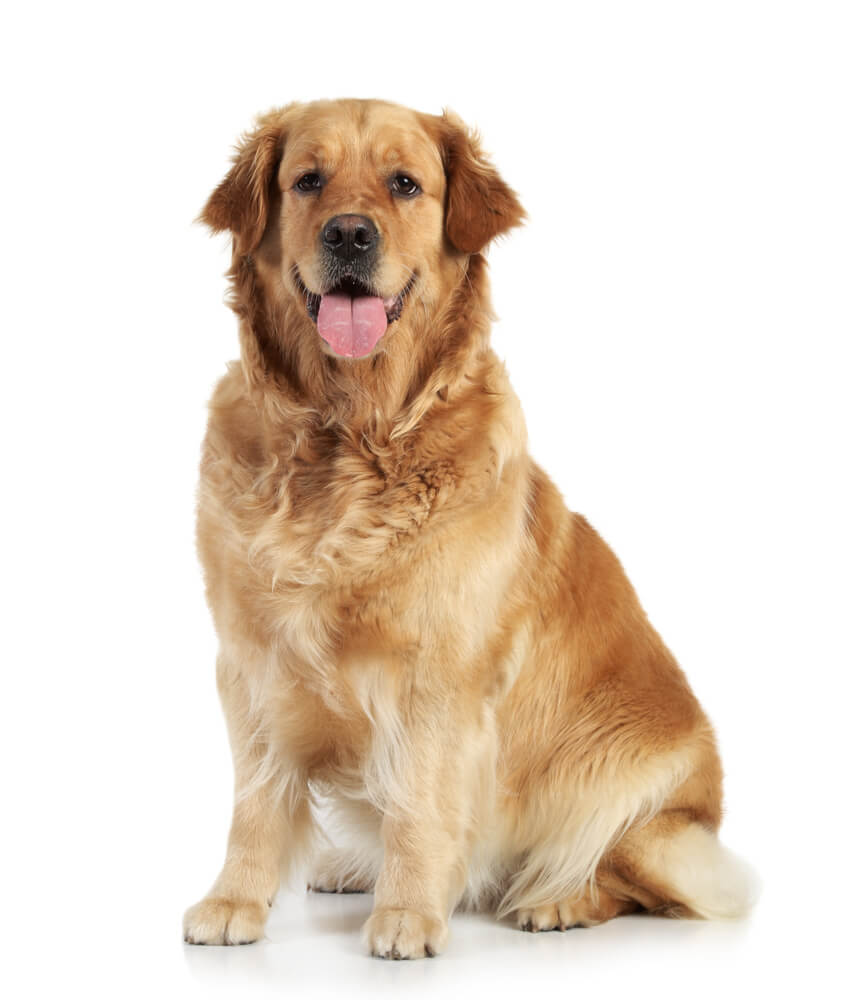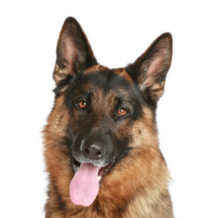Golden Retriever

Golden Retriever breed is originally from United Kingdom. Also known as Yellow Retriever, Golden Flat Coat.
Golden Retriever has friendly and gentle temperament which means that it is unsuited to being a professional guard dog, but its temperament has also made it the third-most popular family dog breed (by registration during 2015-2018) in the United States. The breed is also the 5th-most popular one in Brazil and Australia, and the 8th-most popular in the UK.
Breed information
| Popularity |
|
| Name | Golden Retriever |
| Other names | Yellow Retriever, Golden Flat Coat |
| From country | United Kingdom |
| Standards | |
| Breed groups | Sporting (AKC),Gun Dog (UKC) |
| Type | Purebred |
| Size | Medium, Large, Giant |
| Life span | 10 - 12 years |
| Temperament | confident,friendly,intelligent,kind,reliable,trustworthy |
| Height female | 20-22 inches (51-56 cm) |
| Height male | 22-24 inches (56-61cm) |
| Weight female | 55-70 pounds (25-32 kg) |
| Weight male | 60-80 pounds (27-36 kg) |
| Colors | golden,dark golden,light golden |
| Litter Size | 5 - 10 puppies |
| Puppy Price | Average $1000 - $2000 USD |
Golden Retriever breed image

Golden Retriever Pros and Cons
There are 3 pros and 5 cons of owning Golden Retriever.
| Pros 👍 | Cons 👎 |
|---|---|
| Kid-friendly | Tends to shed a lot |
| Dog-friendly | Difficult to groom |
| High intelligence | Needs more attention to his health |
| Needs a lot of exercises | |
| Not hypoallergenic |
Breed Characteristics
| Sensitivity Level |
Low-sensitive
High-sensitive
|
High-sensitivity dogs can be deeply affected by their owner's actions. If you shout loudly at the dog, ignore it, or if your child pulls its tail, it may take offense. On the other hand, low-sensitivity dogs, often referred to as 'tolerant' dogs, handle these situations more easily. If you're an emotional person, have a busy lifestyle, sometimes neglect your dog, or have young children, we don't recommend getting a high-sensitivity dog. |
|
| Kid-Friendly |
No-Kid-Friendly
Kid-Friendly
|
Kid-friendly dogs are highly tolerant of children's behavior, including hugs and playful "games" like attempting to saddle them. They typically interact kindly and patiently with kids, making them great family pets. Not Kid-Friendly Dogs - Dogs in this category do not tolerate such behavior from children and may react negatively or even aggressively. Be cautious about bringing a not kid-friendly dog into a family environment. |
|
| Dog Friendly |
Low-friendly
High-Friendly
|
Dog-friendly characteristics vary widely, ranging from low-friendly to high-friendly. It's important to note that a dog's level of friendliness depends on several factors, and breed is just one of them. Dogs with high friendliness tend to be sociable and enjoy interacting with other dogs. They may happily play with other canines or simply remain calm and relaxed when in the company of other dogs. Conversely, dogs with lower levels of friendliness may exhibit different behaviors. They might be more prone to barking, trying to engage in fights with other dogs, or even attempting to run away from unfamiliar dogs or situations. Keep in mind that a dog's friendliness is influenced by their individual personality, upbringing, and experiences. So, it's essential to consider these factors when assessing your furry friend's social behavior. |
|
| Friendly Toward Strangers |
Not-friendly
Everyone Is My Best Friend
|
It's important to understand that a dog's behavior towards strangers is influenced by various factors, with breed being just one of them. A dog that is friendly toward strangers will typically exhibit pleasant behavior when your friends or visitors come to your home. They won't display aggression or attempt to attack them. Instead, they will likely be welcoming and sociable. On the other hand, some dogs may be naturally shy or even fearful of strangers. However, it's crucial to note that a dog's socialization plays a significant role in their behavior. Proper socialization lessons can help any dog become more welcoming to strangers, regardless of their breed. That said, if you happen to choose a breed known for its high stranger-friendly rating but don't invest time in training and socialization, the dog may still exhibit unfriendly behavior toward your visitors. Remember, a dog's behavior is a product of both their breed tendencies and their upbringing. |
|
| Amount Of Shedding |
No Shedding
Hair Everywhere
|
|
What's crucial to note is that the extent of shedding can vary from one breed to another. Some dogs shed consistently throughout the year, while others may have specific seasonal shedding patterns. There are also breeds that shed minimally, and in some cases, almost not at all. When choosing a dog, it's essential to consider your personal preferences and standards regarding shedding. Your choice should align with how much you're willing to handle in terms of grooming and cleaning to keep your home and clothes free from excessive dog hair. |
|
| Easy To Groom |
Easy
Hard
|
|
Some breeds are low-maintenance and can be brushed quickly and easily. Others may need regular clipping, grooming, and bathing to keep them looking their best. When choosing a dog, it's important to assess how much time and money you're willing to invest in their grooming needs. Your decision should align with your preferences and your commitment to providing the necessary care for your furry friend. |
|
| General Health |
Need more attention to health
Healthy as an ox
|
|
It's important to be aware that some dogs may face health challenges due to irresponsible breeding practices. One example of such health issues is hip dysplasia, which is a genetic problem. However, it's essential to understand that not every dog of a specific breed will develop these health issues, although they may be more prone to them. When adopting a puppy, it's a good practice to gather information about any genetic illnesses associated with the breed. For more detailed information, you may also want to consult with a shelter or rescue organization, as they can provide insights into the physical health of the puppy's parents or siblings. |
|
| Easy To Train |
Self-Willed
Eager to Please
|
|
It's worth noting that some dog breeds are more trainable than others. For instance, certain breeds may quickly grasp and establish associations between words like 'stay,' corresponding actions (such as staying in place), and the resulting rewards. On the other hand, some breeds may require more time and attention during training. Dogs are highly intelligent animals, but they often like to understand what's in it for them when they follow your commands. This is where games and rewards can be valuable tools in training and motivating them. |
|
| Intelligence |
Low
High
|
|
Different dog breeds excel in specific tasks and exhibit varying levels of intelligence, concentration, and quick decision-making abilities. For instance, breeds bred for their intelligence, like Border Collies, may excel in activities such as herding livestock. These dogs require more mental stimulation to thrive compared to breeds designed for physical endurance and running. Understanding your dog's specific needs is essential to ensure they are mentally engaged and don't engage in unwanted behaviors like chewing and digging. To meet these needs, consider interactive toys and activities, such as obedience training for dogs in need of mental engagement, or search and rescue activities for those with high activity levels and keen senses. |
|
| Tendency To Bark Or Howl |
Only To Alert
Avid singer
|
|
It's important to understand that vocalization varies between dog breeds. Some dogs are naturally more vocal, and they can bark and howl at different pitches. For instance, consider the hound, known for its distinctive barking and howling. You'll need to decide if the sound of their vocalizations might become bothersome or if you find it somewhat musical. Additionally, if your chosen breed has a history of hunting, they might constantly chase and howl at nearby wildlife. If you're looking for a watchdog and your dog is alert, it may bark at everyone it encounters. These factors are essential to consider when selecting a dog breed, especially if you have neighbors or are subject to any noise restrictions. |
|
| Energy Level |
Couch Potato
High Energy
|
|
A dog's energy level is often influenced by their breeding, as some breeds were designed for specific tasks like herding livestock or retrieving game for hunters. Dogs with high energy levels will require plenty of interaction and exercise. They tend to be more active and enjoy activities such as playing, running, tumbling, and exploring new smells and sights. On the other hand, some breeds are low-energy and prefer lounging on the couch with you, taking naps, and enjoying Netflix marathons. When choosing a dog breed, it's essential to consider your own activity level and lifestyle. Select a breed that aligns with your preferences and can comfortably fit into your daily routine. |
|
| Exercise Needs |
Low
Need a lot
|
|
Different dog breeds have varying requirements when it comes to physical activity. Some breeds may be content with a leisurely stroll in the evening, while others might crave several vigorous laps around the block. Their exercise needs are often linked to their original purposes, such as hunting or herding, which influence their energy levels. Dogs with high energy levels that don't receive adequate exercise may be prone to weight gain and may engage in behaviors like digging, chewing, and excessive barking. High-energy dogs tend to thrive when paired with individuals who are active, enjoy the outdoors, or have an interest in training their dog for competitions. |
|
| Potential For Playfulness |
Only When You Want To Play
Non-Stop
|
|
Dog breeds exhibit a wide range of personalities, and this includes their inclination for play. Some breeds are consistently playful and seem to stay in a perpetual puppy state of mind. In contrast, other breeds tend to be more serious and enjoy their moments of relaxation. When choosing a dog, it's important to consider whether the idea of having a playful companion excites you or if you prefer a more relaxed and laid-back dog. Additionally, factors such as the presence of children or other pets in your household should be taken into account. Another option to explore is adopting an older dog, which might be less demanding but still enjoys interacting and playing, providing a balance between playfulness and a calmer demeanor. |
|
Basic moments
- Ideal hosts for the Golden Retriever are families with children, as well as active people who love outings and long walks. For couch potatoes and adherents of laxed pace of life, the dog will deliver more in convenience than in positive emotions.
- Representatives of this breed are quite silent and patient. They do neither raise a fuss over trifles and nor annoy with loud barking.
- These dogs are smart and quick-witted. Ranked 4th in the list of the most intellectually developed breeds according to Stanley Coren.
- Among hunters, golden retrievers have a reputation for being the best game carriers, capable of wading in search of prey even through difficult thickets.
- Due to the abundant spontaneous molting, the breed is not suitable for fans of cleanliness and allergy sufferers.
- Golden Retrievers are capable learners, grasping even the most difficult material with ease. With a timely completion of the training course, they become excellent guides, rescuers and search engines.
- Despite their friendly and outgoing nature, retrievers need training and a steady hand. A dog that does not recognize the master’s authority becomes uncontrollable and can create a lot of problems.
- Golden Retrievers have a real passion for water and take a bath with pleasure in any open water, and if overlooked, in puddles.
- The owners often call their pets simply golden.
History of the Golden Retriever breed
The main prerequisite for emergence of the breed was an eternal passion of the English aristocrats for hunting. In the 19th century, the main entertainment of British and Scottish Esquires was hunting and shooting ducks. The venerable peers disappeared for days in the forests and in the swamps, boasting to each other with their trophies, guns and, of course, dogs. However, if the gentlemen had complete order with the hounds, then four-footed hunters, able to find as hot quail in the heather thickets or swim after a duck that fell into the lake, were in great deficit. Commercial demand generated supply, and soon shaggy dogs with an unusual golden coat began to dissect through the valleys of Scotland.
The emergence of Golden Retrievers as an independent breed is usually associated with the name of Dudley Marjori banks, a Scottish lord and part-time breeder-amateur. He showed the world a completely new variety of the hunter dog, who was not afraid of water and who skillfully imported a padded bird. For a long time it remained a mystery, whose blood flows in the wards of the lord, until in the middle of the 20th century, the secret records of his studbooks were made public. As it turned out, the Goldens were given their genes by the Water Tweed Spaniel, Labrador, Bloodhound and Straight-haired Retriever. At the same time, the first offspring were obtained as a result of mating a tweed water spaniel and a straight-haired retriever, which had a yellowish coat.
By the 20s of the last century, the breed was already quite popular not only in Europe, but also among breeders of the New World. In addition, the USA and Canada have formed their own standards for the appearance of Golden Retrievers. So, for example, overseas, individuals with a more intense and dark coat color were preferred.
Golden Retriever's appearance
Golden Retrievers are moderately pumped up handsome men with heartfelt eyes and luxurious iridescent hair. Goldens owe their recognition not so much to their own charm as to the efforts of marketers. The breed was especially actively promoted by American cinema. It is enough to watch a couple of comedy melodramas produced in the USA to understand, if an American family ever decides to have a dog, then in 9 cases out of 10 it will be a Golden Retriever.
The sexual type in representatives of this breed is pronounced. The growth of an average males ranges from 56-60 cm, and his weight can reach 41kg. Females are much lighter (average weight— 25-37 kg) and smaller than males (height— 51-56 cm).
Despite the presence of a single breed standard approved by the FCI, experts divide golden retrievers into three types:
- English;
- American;
- Canadian.
Representatives of the first group are the natives of Foggy Albion, with extremely massive legs and a wide skull. They are distinguished by a lighter coat color, up to white. It is the English type that is most common in Europe and Russia. The range of American breeders wards is less impressive, but from USA Golden Retrievers boast a graceful posture and generally more elegant appearance. At the same time, the shade of their coat is so me what darker than that of their British counterparts. A distinctive feature of Canadian retrievers is a thin physique with a fairly high growth. The coat color of the “Canadians” is even more intense and darker than that of the “Americans”.
Head
The skull is massive, convex-angular. The transition from forehead to muzzle is distinct and smooth. The occipital protuberance is smoothed, the cheeks are flat. The animal’s muzzle is long, even, gradually tapering from base to nose.
Lips
Black, moderately dense and dry. The upper lip hangs noticeably over the lower lip, but does not go beyond the jaw. The lips completely hide the dog's teeth and gums, forming small folds at the corners of the mouth.
Jaws and teeth
The retriever's jaws are strong and fairly wide, with a pronounced scissor bite. The teeth are white and large. The incisors are aligned.
Nose
The lobe is massive, mobile and black. The nostrils are wide open.
Ears
Moderately long, hanging, lowered along the cheeks of the animal. The base of the ear is wide, the tip is narrow, smooth and rounded. Placement - slightly above the line of the eyes.
Eyes
Large, deep-set, rounded. The golden retriever has a smart, friendly look. The color of the iris is from brown to dark brown. The eyelids are black, dry, close to the eyeball. An important condition: in a dog looking straight, the whites of the eyes should not be visible.
Neck
Massive, set high and of moderate length. The neck muscles are strong, developed, there are no folds or sagging.
Body
Adults have a strong, tightly knit body with prominent muscles. The back of Golden Retrievers is straight, with a prominent loin and pronounced withers. The croup is massive, slightly sloping, rounded. The rib cage is of moderate width, sufficiently deep. The tucked-up belly line ends with a short and well-fitting groin area.
Tail
Moderately long, with a wide, thickened base and a tapered tip. Located below the back. In a calm golden, the tail is lowered, in an excited golden, it is raised to the level of the back.
Limbs
The forelegs are well muscled, dry and straight. The shoulders are strong, with massive shoulder blades and the elbows laid back against the body. The shoulder angle does not exceed 90 degrees. The pasterns are strong, but short, set at a slight slope.
The hind legs are strong, with well-developed muscles, well spaced apart from each other. The hock joint in Golden Retrievers is low and pointing backwards. Front and hind feet are of medium size, rounded. The pads are massive, with short claws; the fingers of the animal are folded into a ball.
Wool
The coat of the Golden Retriever is very hard and water-repellent. The hair is quite thick and fits snugly to the body, hiding an abundant undercoat underneath. The structure of the coat can be straight or have alight wave, and its length varies depending on the part of the body. The longest coat is found on the chest, ears, body, back of all four legs, and the lower part of the tail. Areas of the body with short hair are the head, feet and front of the limbs.
Color
All shades of gold are considered reference, up to the transition to cream color. Lighter colors are acceptable for feathering on paws and tail suspension.
Possible defects
The list of breed defects includes any deviations from the characteristics prescribed by the standard. For example, it is undesirable for a golden retriever to have sparse and long hair, white stripes on the chest, and eyes that are too light and close-set. The following vices may be the reason not to allow the animal to compete:
- square case;
- long or too short legs;
- malocclusion and skewed lower jaw;
- cryptorchidism;
- lips, eyelids and nose, painted in any shade except black;
- a white "scarf" around the neck and blurs on the forehead;
- black coat color, as well as the presence of spots on it;
- drooping tail.
Angry or conversely cowardly individuals, “goldens” with a small head, short ears or small teeth will also not make a serious career.
Video Is the Amazing Golden Retriever the Perfect Dog?
Video about Golden Retriever breed
Questions and answers about Golden Retriever
Yes, Golden Retriever's typical characteristics indicate that this breed of dog is an ideal companion for kids and makes it a family pet. But anyway You mustn't leave the kid and dog alone!
The average life expectancy of a Golden Retriever is between 10 - 12 years.
If your Golden Retriever is pregnant, it is safe to assume that litter can have anywhere from 5 to 10 puppies.
If you purchase Golden Retriever from a breeder it can be much more expensive than a shelter. A purebred Golden Retriever costs between US$ 1000 and US$ 2000 from a reputable breeder, but there are several advantages to doing so. First, a breeder will usually allow you to meet the parents to get a good idea about what the puppy will look like and behave. You will also see if the parents have any health problems. Breeders will also supply you with paperwork that documents your pet’s lineage.
Yes, Golden Retriever has captured the hearts of Americans and become a beloved and highly sought-after breed. It's in top 3 the most popular purebred dog in USA. Golden Retriever have got #4 rank in 2020, #3 in 2021 and #3 in 2022 by American Kennel Club (AKC).
No, Golden Retriever are not considered hypoallergenic dogs. If you are thinking about getting a Golden Retriever and have allergies, it's important to spend time with the breed to see how you react before bringing one into your home. This can help you make an informed decision about whether a Golden Retriever is the right pet for you, and if so, what steps you may need to take to manage any allergy symptoms.
- https://www.akc.org
- FCI standard
- Kennel club standard
- Wikipedia https://en.wikipedia.org/wiki/Golden_Retriever
Next and previous breeds by Popularity

Labrador Retriever
Popularity: №2

German Shepherd
Popularity: №4